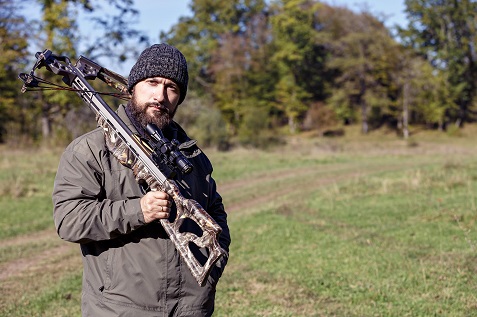Beginner’s Guide to Crossbow Hunting

Before you get started with crossbow hunting, take some time to familiarize yourself with any local regulations that might affect your hunting plans. While crossbows are widely accepted in most states, some have designated crossbow permits and hunting seasons.
Understanding the crossbow
A crossbow is an unusual combination of a hunting bow and a muzzle-loading rifle, yet they are nothing new. Evidence of people using crossbows go all the way back to 4th century B.C. in China. Today’s crossbows are modern and powerful hunting weapons. Unlike rifles, crossbows are meant for short-range hunting. To be efficient and accurate, it’s best to take shots within 30 yards.
On top of the crossbow, you’ll find the stirrup. You place a foot in the stirrup to secure the bow while you pull the string back to cock it. Crossbows feature two sights just like rifles: the front sight near the tip of the bow and the main sight at the base of the stock. The addition of a scope doesn’t make a crossbow a long-range weapon, but it can improve accuracy in low-light conditions. The rail is the slot where you place the bolt. A bolt is like a normal arrow but shorter. The safety button prevents the trigger from engaging. The trigger disengages the lock and allows the string to release, launching the bolt toward the target.
How to cock and fire a crossbow
Crossbows feature a bowstring that is drawn into the safety mechanism or lock. Once cocked, the string is locked back. The trigger mechanism disengages the lock to disengage and fire the bolt. The locking mechanism allows you to aim the crossbow like a rifle.
The most basic way is to use the stirrup and pull the string up manually to engage the safety mechanism. More commonly, people use a rope cock, which features two handles on a strong rope with metal or plastic clips that attach to the bowstring.
The device makes the crossbow easier to cock and the bowstring tension more even than manual cocking.
Some crossbows have mechanical cocking devices that allow you to turn the crank and cock the bow. The pros of a mechanical crank are that they make high-tension crossbows easier to cock, but cranks are often noisy.
Selecting a crossbow
Crossbows range from several hundred dollars to more than $2,000. Depending on your budget, you can find a crossbow that will work for you. The more expensive models are often quieter and have more features than the basic models. Full-size crossbows are safer and more accurate than pistol crossbows. For serious hunting, a full-sized crossbow will serve you best.
Regarding weight and power, the longer the power stroke, the faster the bow. Heavier crossbows will be more stable and accurate than their lighter counterparts. Advertised crossbow speeds aren’t standardized in the same way as traditional bows. The speed, poundage and weight of the bolt all affect the actual speed. For smaller hunters, the size of the crossbow can be tricky. Make sure you’re tall enough to cock your crossbow.
Hunting Tips
Get your bow sighted well and spend some time practicing before you get out in the field with a crossbow. You’ll probably only get one shot, so you want to make it count.
Crossbows are louder than regular bows, so keep in mind that the game you’re hunting will hear the shot. Keep in mind that you won’t be afforded the kind of range you’d get with a rifle. You’ll have to be patient with your game since you need to be in range of about 30-40 yards. Before your grab your bow and head out to your favorite hunting spot, make sure you’ve got all the layers, camo and durable hunting gear you need for a great trip. If you need any of these items, visit a trusted outfitter like Carhartt to stock up on the essentials.





